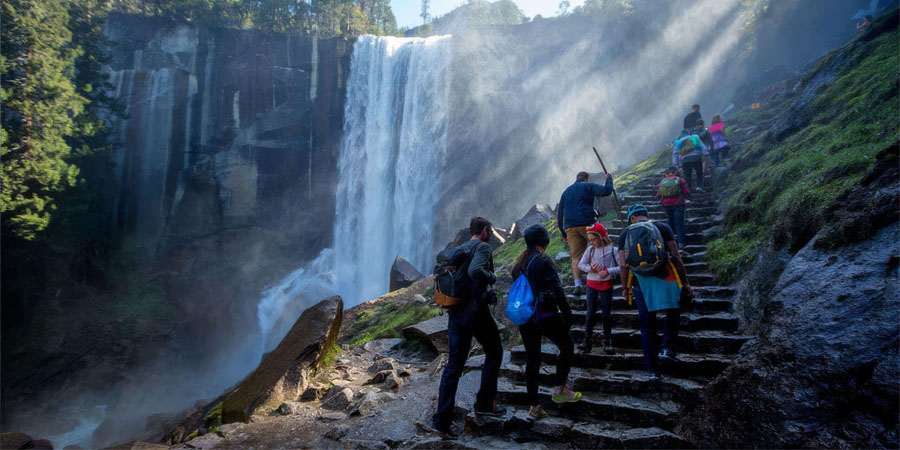Niagara Falls stands as one of the most famous natural wonders of the world, captivating millions of tourists every year with its immense power, stunning beauty, and rich history. Straddling the international border between Canada’s Ontario province and the U.S. state of New York, Niagara Falls is not just one but a group of three waterfalls that together make up this spectacular natural phenomenon.
The Three Waterfalls of Niagara
Niagara Falls comprises three distinct waterfalls: Horseshoe Falls, the American Falls, and the Bridal Veil Falls. These waterfalls are formed by the Niagara River, which drains water from Lake Erie and channels it over the Niagara Escarpment into Lake Ontario.
- Horseshoe Falls: Also called the Canadian Falls, Horseshoe Falls is the largest and most impressive of the three. It curves gracefully with a crest approximately 2,200 feet (670 meters) wide and a vertical drop of about 188 feet (57 meters). The majority of the Niagara River’s water flows over Horseshoe Falls, making it the most powerful waterfall in North America by volume of water.
- American Falls: Located on the U.S. side, this waterfall is slightly smaller than Horseshoe Falls. It stands around 190 feet (58 meters) tall with a crest width of about 1,060 feet (320 meters). Unlike Horseshoe Falls, its rock-strewn base creates a turbulent flow that makes it visually distinct.
- Bridal Veil Falls: This smallest of the trio is separated from American Falls by Luna Island and from Horseshoe Falls by Goat Island. Its name is derived from the waterfall’s delicate, veil-like appearance as it cascades down. Though smaller, Bridal Veil Falls adds to the overall grandeur of the Niagara Falls complex.
Geological Formation and Evolution
The formation of Niagara Falls dates back over 12,000 years to the end of the last Ice Age. As glaciers melted, massive volumes of water started flowing from newly formed Great Lakes into the Niagara River. The force of the water carved a path over the Niagara Escarpment, a steep cliff of layered sedimentary rock, creating the waterfall.
The geology of the region is particularly interesting. A hard dolomite cap overlays softer layers of shale and limestone beneath. This configuration causes water to erode the softer rock at a faster rate, occasionally undercutting the harder layer above, leading to frequent rockfalls. This natural process causes the waterfalls, especially Horseshoe Falls, to slowly move upstream, carving out the famous Niagara Gorge over thousands of years.
To preserve the falls and manage erosion rates, human interventions have redirected some water for hydroelectric power generation and implemented various engineering measures since the 19th century.
Historical and Cultural Significance
Niagara Falls has long been revered and admired by indigenous peoples, who lived in the region long before European explorers arrived. The first European to document Niagara Falls was French priest Father Louis Hennepin in 1678, whose vivid descriptions introduced the natural wonder to the wider world.
The falls became increasingly popular in the 19th and 20th centuries as advancements in rail travel made Niagara much more accessible. Visitors flocked to admire its thrilling beauty and enjoy the surrounding parks and attractions. Niagara Falls also became known as a prime location for daredevils attempting to go over the falls in barrels and other contraptions, adding to the mystique and allure.
Today, the area surrounding Niagara Falls is a major tourist hub with renowned landmarks such as the Maid of the Mist boat tours, which take visitors close to the roaring waters, and the Cave of the Winds walkways, which provide breathtaking views right at the base of the falls.
Niagara Falls as a Source of Power
Apart from its aesthetic value, Niagara Falls has been a crucial source of hydroelectric power since the late 19th century. The falls’ vast flow rate and height make them ideally suited for generating electricity. Both the United States and Canada have developed extensive hydroelectric facilities that harness the river’s power while balancing ecological and recreational considerations.
This dual use of Niagara Falls showcases a successful melding of industrial innovation and natural preservation, serving as a model for sustainable use of natural resources.
Tourism and Visitor Experience
Niagara Falls attracts over 12 million visitors each year, drawn by its awe-inspiring vistas and wide range of activities. Visitors can stroll through landscaped parks, ride boat tours to the foot of the falls, explore observation decks, and enjoy local museums and attractions.
The falls are a year-round destination, offering a dramatically different experience with each season—from the lush greenery of summer to the frosty, ice-covered landscapes of winter and the spectacular autumn foliage. The iconic illumination of the falls at night adds a magical element for tourists.
Fun Facts About Niagara Falls
- In peak flow conditions, more than 168,000 cubic meters (5.9 million cubic feet) of water plunge over Niagara Falls every minute.
- Horseshoe Falls carries approximately 90% of the Niagara River’s water flow.
- Niagara Falls is frequently called the honeymoon capital of the world, a tradition begun when Napoleon Bonaparte’s brother honeymooned there in the early 1800s.
- The falls have moved upstream about seven miles (11 kilometers) due to erosion since their formation.
Conclusion
Niagara Falls with autumn foliage, located between Ontario, Canada, and New York, USA
Niagara Falls stands as a natural spectacle of unparalleled beauty and power, a symbol of North America’s geological history and a hub of tourism and renewable energy innovation. Whether witnessing the thunderous roar of Horseshoe Falls, the rugged charm of American Falls, or the delicate cascade of Bridal Veil Falls, visitors are awed by the majesty of this iconic landmark. Niagara Falls continues to inspire wonder, admiration, and respect as a treasured natural wonder straddling the border between Canada and the United States.
This 800-word article provides a rich, unique overview of Niagara Falls covering its geography, geology, history, cultural significance, tourism, and ecological value.


